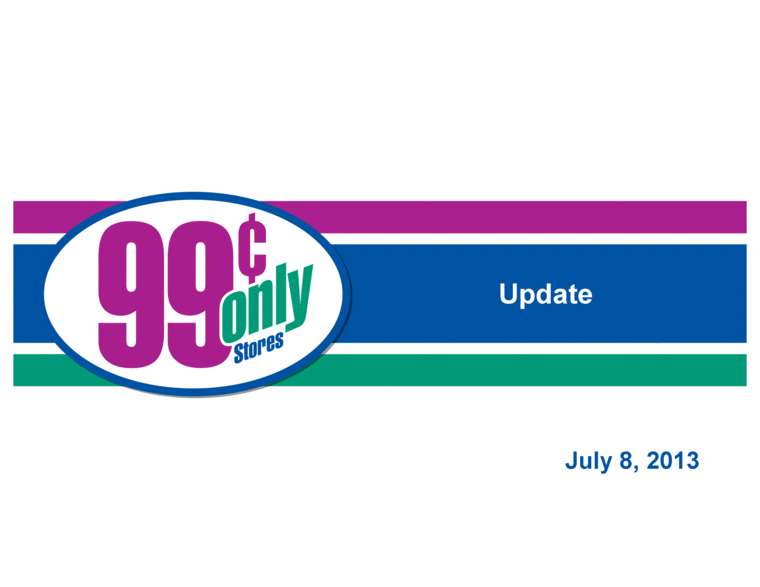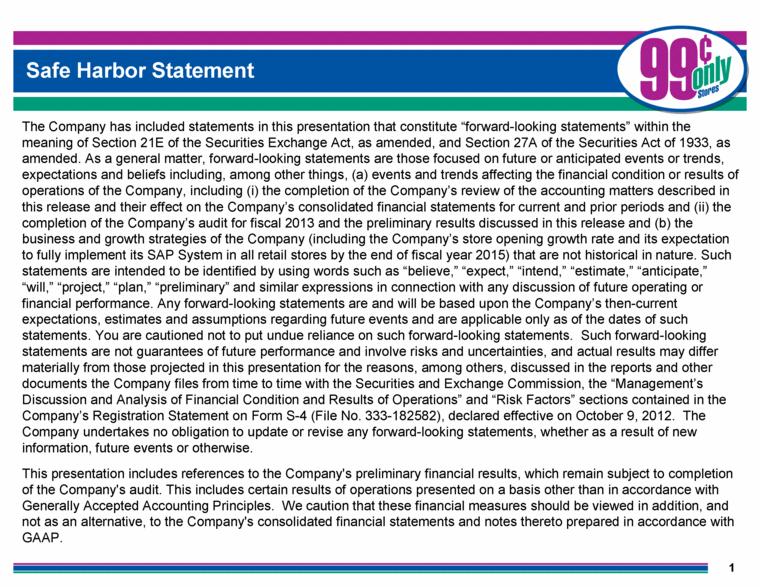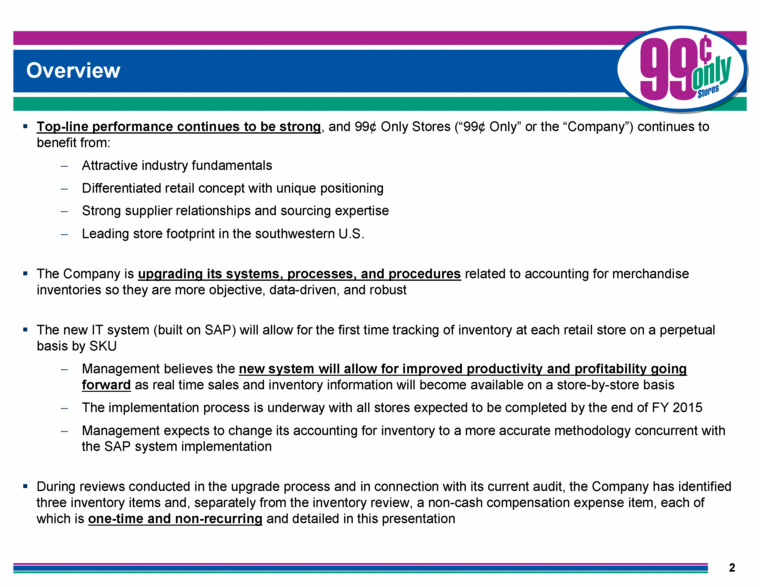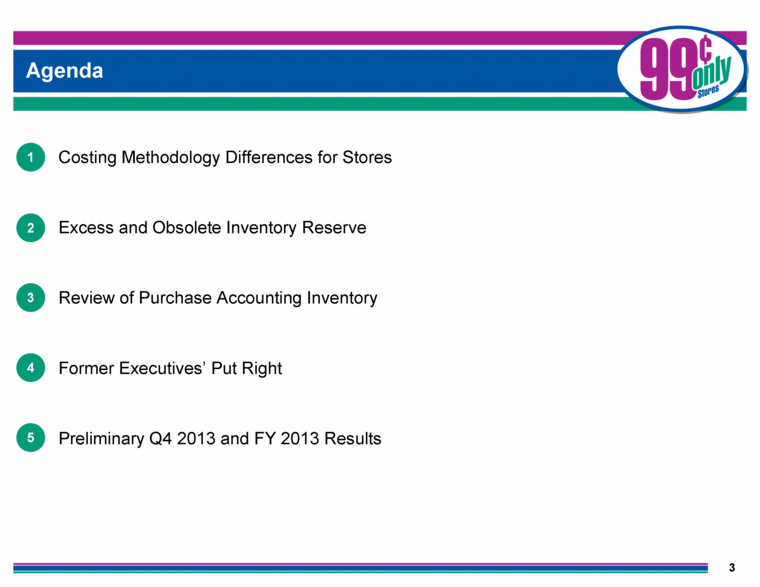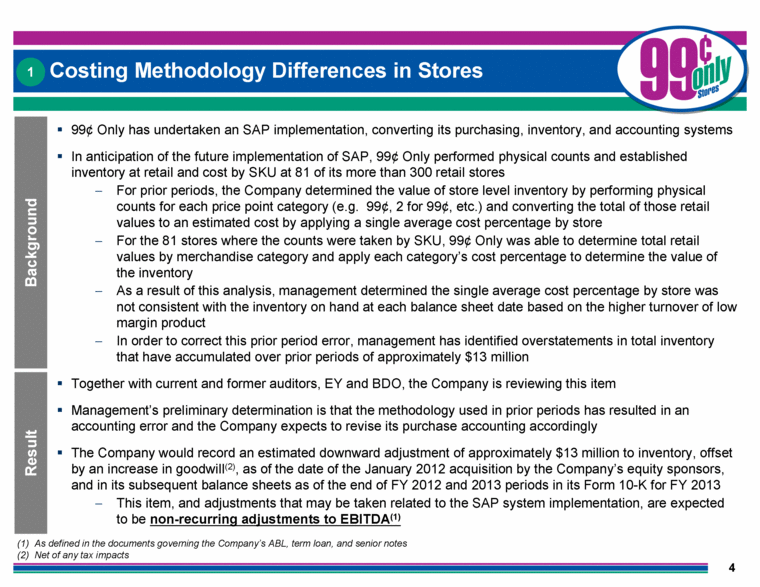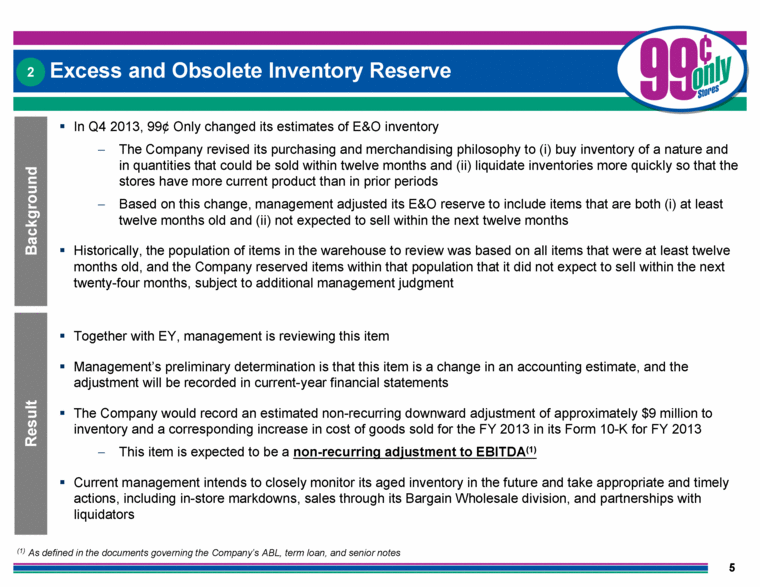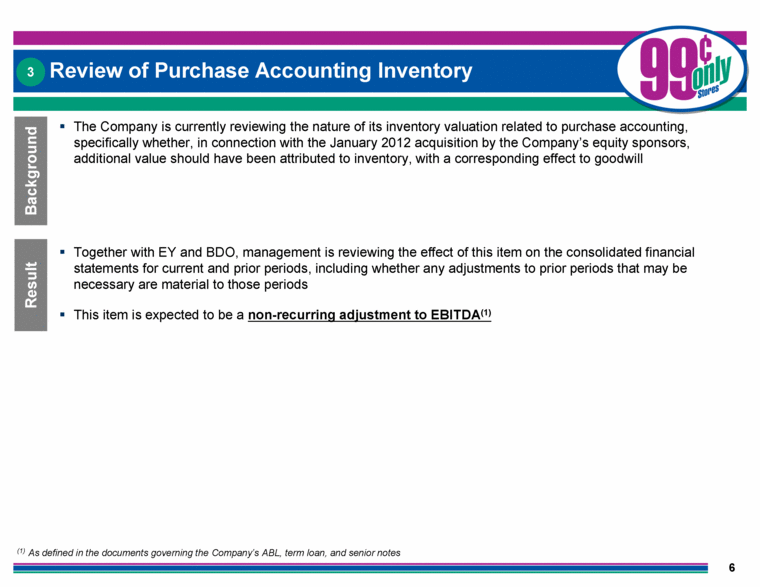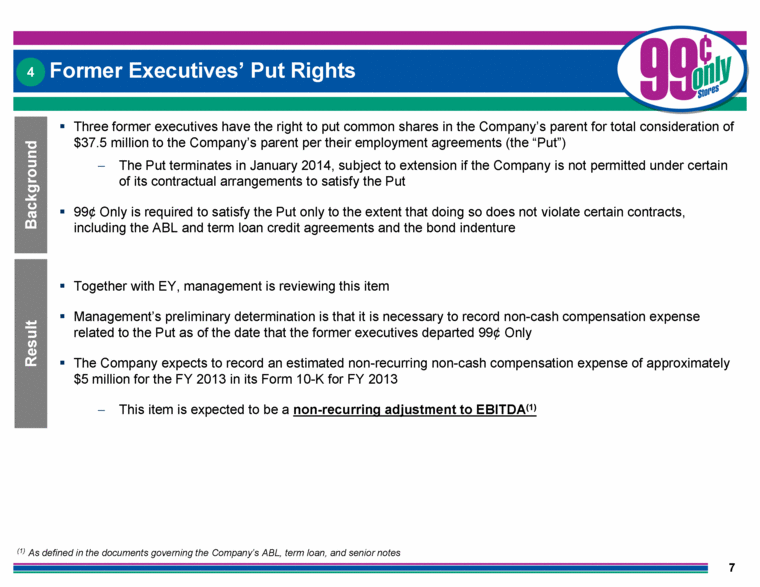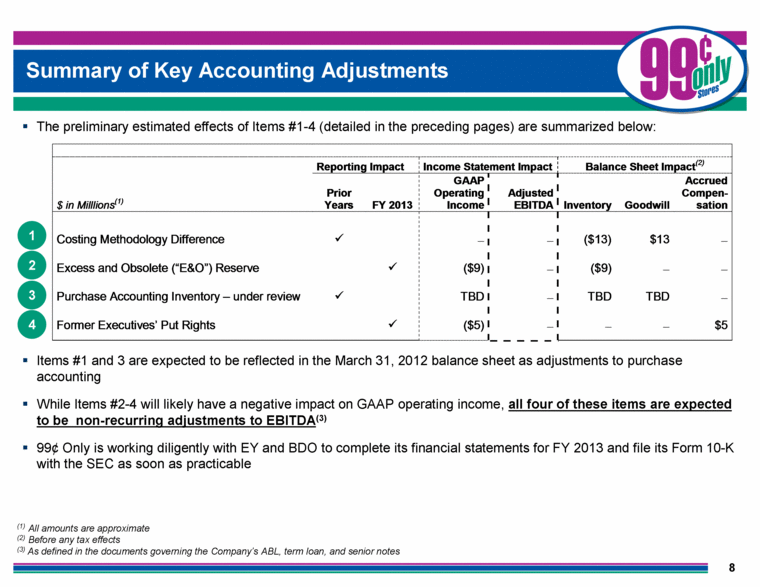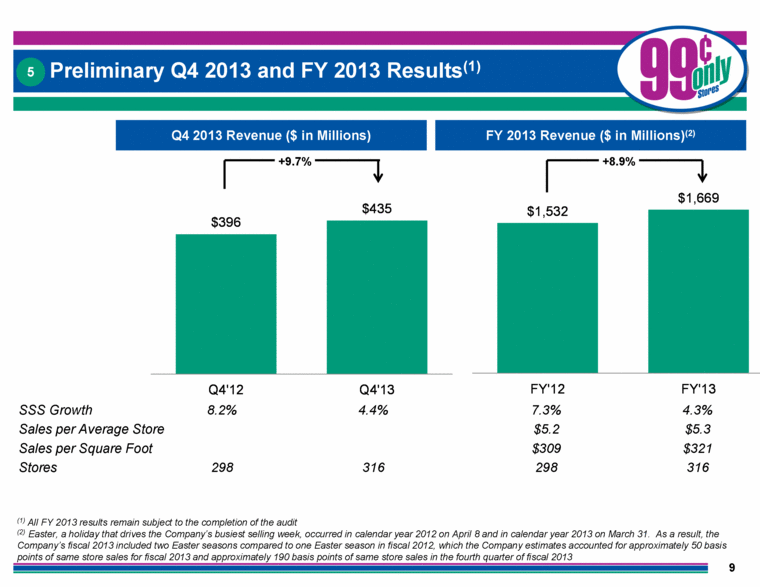Attached files
| file | filename |
|---|---|
| 8-K - 8-K - 99 CENTS ONLY STORES LLC | a13-16257_18k.htm |
Exhibit 99.1
|
|
Update July 8, 2013 |
|
|
Safe Harbor Statement 1 The Company has included statements in this presentation that constitute “forward-looking statements” within the meaning of Section 21E of the Securities Exchange Act, as amended, and Section 27A of the Securities Act of 1933, as amended. As a general matter, forward-looking statements are those focused on future or anticipated events or trends, expectations and beliefs including, among other things, (a) events and trends affecting the financial condition or results of operations of the Company, including (i) the completion of the Company’s review of the accounting matters described in this release and their effect on the Company’s consolidated financial statements for current and prior periods and (ii) the completion of the Company’s audit for fiscal 2013 and the preliminary results discussed in this release and (b) the business and growth strategies of the Company (including the Company’s store opening growth rate and its expectation to fully implement its SAP System in all retail stores by the end of fiscal year 2015) that are not historical in nature. Such statements are intended to be identified by using words such as “believe,” “expect,” “intend,” “estimate,” “anticipate,” “will,” “project,” “plan,” “preliminary” and similar expressions in connection with any discussion of future operating or financial performance. Any forward-looking statements are and will be based upon the Company’s then-current expectations, estimates and assumptions regarding future events and are applicable only as of the dates of such statements. You are cautioned not to put undue reliance on such forward-looking statements. Such forward-looking statements are not guarantees of future performance and involve risks and uncertainties, and actual results may differ materially from those projected in this presentation for the reasons, among others, discussed in the reports and other documents the Company files from time to time with the Securities and Exchange Commission, the “Management’s Discussion and Analysis of Financial Condition and Results of Operations” and “Risk Factors” sections contained in the Company’s Registration Statement on Form S-4 (File No. 333-182582), declared effective on October 9, 2012. The Company undertakes no obligation to update or revise any forward-looking statements, whether as a result of new information, future events or otherwise. This presentation includes references to the Company's preliminary financial results, which remain subject to completion of the Company's audit. This includes certain results of operations presented on a basis other than in accordance with Generally Accepted Accounting Principles. We caution that these financial measures should be viewed in addition, and not as an alternative, to the Company's consolidated financial statements and notes thereto prepared in accordance with GAAP. |
|
|
Overview 2 Top-line performance continues to be strong, and 99¢ Only Stores (“99¢ Only” or the “Company”) continues to benefit from: Attractive industry fundamentals Differentiated retail concept with unique positioning Strong supplier relationships and sourcing expertise Leading store footprint in the southwestern U.S. The Company is upgrading its systems, processes, and procedures related to accounting for merchandise inventories so they are more objective, data-driven, and robust The new IT system (built on SAP) will allow for the first time tracking of inventory at each retail store on a perpetual basis by SKU Management believes the new system will allow for improved productivity and profitability going forward as real time sales and inventory information will become available on a store-by-store basis The implementation process is underway with all stores expected to be completed by the end of FY 2015 Management expects to change its accounting for inventory to a more accurate methodology concurrent with the SAP system implementation During reviews conducted in the upgrade process and in connection with its current audit, the Company has identified three inventory items and, separately from the inventory review, a non-cash compensation expense item, each of which is one-time and non-recurring and detailed in this presentation |
|
|
Agenda 3 1 2 Costing Methodology Differences for Stores Excess and Obsolete Inventory Reserve Review of Purchase Accounting Inventory Former Executives’ Put Right Preliminary Q4 2013 and FY 2013 Results 3 4 5 |
|
|
Costing Methodology Differences in Stores 4 99¢ Only has undertaken an SAP implementation, converting its purchasing, inventory, and accounting systems In anticipation of the future implementation of SAP, 99¢ Only performed physical counts and established inventory at retail and cost by SKU at 81 of its more than 300 retail stores For prior periods, the Company determined the value of store level inventory by performing physical counts for each price point category (e.g. 99¢, 2 for 99¢, etc.) and converting the total of those retail values to an estimated cost by applying a single average cost percentage by store For the 81 stores where the counts were taken by SKU, 99¢ Only was able to determine total retail values by merchandise category and apply each category’s cost percentage to determine the value of the inventory As a result of this analysis, management determined the single average cost percentage by store was not consistent with the inventory on hand at each balance sheet date based on the higher turnover of low margin product In order to correct this prior period error, management has identified overstatements in total inventory that have accumulated over prior periods of approximately $13 million Together with current and former auditors, EY and BDO, the Company is reviewing this item Management’s preliminary determination is that the methodology used in prior periods has resulted in an accounting error and the Company expects to revise its purchase accounting accordingly The Company would record an estimated downward adjustment of approximately $13 million to inventory, offset by an increase in goodwill(2), as of the date of the January 2012 acquisition by the Company’s equity sponsors, and in its subsequent balance sheets as of the end of FY 2012 and 2013 periods in its Form 10-K for FY 2013 This item, and adjustments that may be taken related to the SAP system implementation, are expected to be non-recurring adjustments to EBITDA(1) (1) Background Result As defined in the documents governing the Company’s ABL, term loan, and senior notes (2) Net of any tax impacts |
|
|
Excess and Obsolete Inventory Reserve 5 In Q4 2013, 99¢ Only changed its estimates of E&O inventory The Company revised its purchasing and merchandising philosophy to (i) buy inventory of a nature and in quantities that could be sold within twelve months and (ii) liquidate inventories more quickly so that the stores have more current product than in prior periods Based on this change, management adjusted its E&O reserve to include items that are both (i) at least twelve months old and (ii) not expected to sell within the next twelve months Historically, the population of items in the warehouse to review was based on all items that were at least twelve months old, and the Company reserved items within that population that it did not expect to sell within the next twenty-four months, subject to additional management judgment Together with EY, management is reviewing this item Management’s preliminary determination is that this item is a change in an accounting estimate, and the adjustment will be recorded in current-year financial statements The Company would record an estimated non-recurring downward adjustment of approximately $9 million to inventory and a corresponding increase in cost of goods sold for the FY 2013 in its Form 10-K for FY 2013 This item is expected to be a non-recurring adjustment to EBITDA(1) Current management intends to closely monitor its aged inventory in the future and take appropriate and timely actions, including in-store markdowns, sales through its Bargain Wholesale division, and partnerships with liquidators 2 Background Result (1) As defined in the documents governing the Company’s ABL, term loan, and senior notes |
|
|
Review of Purchase Accounting Inventory 6 The Company is currently reviewing the nature of its inventory valuation related to purchase accounting, specifically whether, in connection with the January 2012 acquisition by the Company’s equity sponsors, additional value should have been attributed to inventory, with a corresponding effect to goodwill Together with EY and BDO, management is reviewing the effect of this item on the consolidated financial statements for current and prior periods, including whether any adjustments to prior periods that may be necessary are material to those periods This item is expected to be a non-recurring adjustment to EBITDA(1) 3 Background Result (1) As defined in the documents governing the Company’s ABL, term loan, and senior notes |
|
|
Former Executives’ Put Rights 7 Three former executives have the right to put common shares in the Company’s parent for total consideration of $37.5 million to the Company’s parent per their employment agreements (the “Put”) The Put terminates in January 2014, subject to extension if the Company is not permitted under certain of its contractual arrangements to satisfy the Put 99¢ Only is required to satisfy the Put only to the extent that doing so does not violate certain contracts, including the ABL and term loan credit agreements and the bond indenture Together with EY, management is reviewing this item Management’s preliminary determination is that it is necessary to record non-cash compensation expense related to the Put as of the date that the former executives departed 99¢ Only The Company expects to record an estimated non-recurring non-cash compensation expense of approximately $5 million for the FY 2013 in its Form 10-K for FY 2013 This item is expected to be a non-recurring adjustment to EBITDA(1) 4 Background Result (1) As defined in the documents governing the Company’s ABL, term loan, and senior notes |
|
|
Summary of Key Accounting Adjustments 8 The preliminary estimated effects of Items #1-4 (detailed in the preceding pages) are summarized below: Items #1 and 3 are expected to be reflected in the March 31, 2012 balance sheet as adjustments to purchase accounting While Items #2-4 will likely have a negative impact on GAAP operating income, all four of these items are expected to be non-recurring adjustments to EBITDA(3) 99¢ Only is working diligently with EY and BDO to complete its financial statements for FY 2013 and file its Form 10-K with the SEC as soon as practicable 1 2 (1) All amounts are approximate (2) Before any tax effects (3) As defined in the documents governing the Company’s ABL, term loan, and senior notes 3 4 Reporting Impact Income Statement Impact Balance Sheet Impact(2) $ in Milllions(1) Prior Years FY 2013 GAAP Operating Income Adjusted EBITDA Inventory Goodwill Accrued Compen-sation Costing Methodology Difference $13 $13 Excess and Obsolete (“E&O”) Reserve $9 $9 Purchase Accounting Inventory – under review TBD TBD TBD Former Executives’ Put Rights $5 $5 |
|
|
+8.9% +9.7% Preliminary Q4 2013 and FY 2013 Results(1) 9 5 $5.2 $5.3 SSS Growth 7.3% 4.3% Q4 2013 Revenue ($ in Millions) FY 2013 Revenue ($ in Millions)(2) $309 $321 Stores 298 316 8.2% 4.4% 298 316 (1) All FY 2013 results remain subject to the completion of the audit (2) Easter, a holiday that drives the Company’s busiest selling week, occurred in calendar year 2012 on April 8 and in calendar year 2013 on March 31. As a result, the Company’s fiscal 2013 included two Easter seasons compared to one Easter season in fiscal 2012, which the Company estimates accounted for approximately 50 basis points of same store sales for fiscal 2013 and approximately 190 basis points of same store sales in the fourth quarter of fiscal 2013 Sales per Average Store Sales per Square Foot $396 $435 Q4'12 Q4'13 $1,532 $1,669 FY'12 FY'13 |

